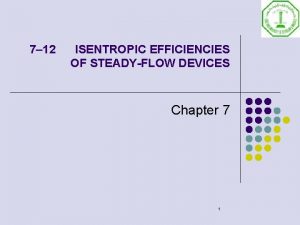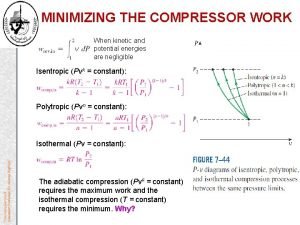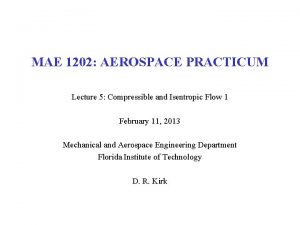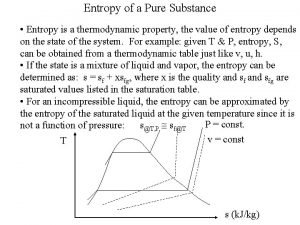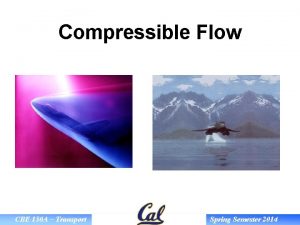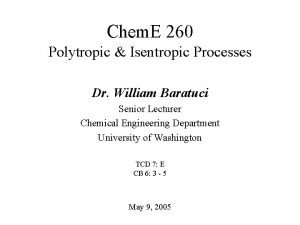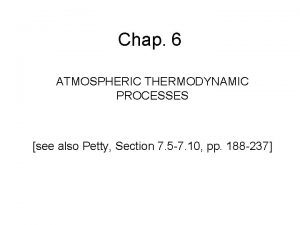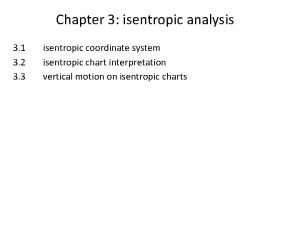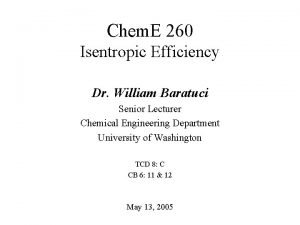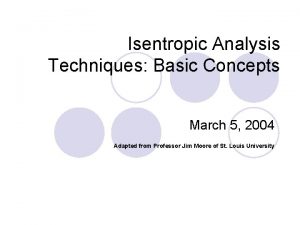Isentropic flow th 4 lecture Introduction In case










- Slides: 10

Isentropic flow th 4 lecture Introduction: In case of real compressible flow, there are mainly three effects affecting the flow, namely: the geometry of the duct, the friction, and the heat interaction. Theses major variables are found together in the real flow. To study the effect of the individual one, the two other ones are set constant. That means at first changing the duct geometry is studied for frictionless flow and no heat interaction, which is called isentropic flow. After that the area of the duct will be set constant and no heat interaction is considered. The only parameter in this case is the friction effect. In the same manner, the heat interaction will be studied. Flow in a duct of a varying cross-sectional area

and From these relation the following figures can be drawn

A change of area produces opposite effects on subsonic and supersonic flows. A convergent duct forms a nozzle if M 1, but it is supersonic diffuser if M 1. When M is different from 1 and d. A=0, then d. V, dp, and d must equal 0, according to the last equations. However, no changes of V, p, or also occur when d. A=0 and M=1, conditions which can exist at the throat of a nozzle. For subsonic flow in a convergent duct, the flow cannot accelerate beyond Mach number 1. But if the converging duct is followed by a diverging section, the flow, depending on the exit pressure, may accelerate from a subsonic velocity at the inlet to supersonic velocity at the exit. At the throat of a nozzle the transition between the converging and diverging portions must occur smoothly, to accelerate continuously. Sonic velocity does not occur in converging or diverging parts of the nozzle, it occur only at the throat.


Property relations for isentropic flow of a perfect gas • From the energy equation, the stagnation– to static- temperature can be related as: Combining these two equations with the last one, we get the following relations.

Stagnation properties are obtained from the last equations by substituting M=1:


Reference speeds • • There are three speeds can be attained in a duct, which are fixed for a certain stagnation condition. These speeds or velocities are theoretical maximum speed of the flow could be reached, the stagnation sound speed referred to the stagnation temperature, and the critical velocity reached at the throat for Mach=1 The maximum velocity attainable is reached when the absolute temperature of fluid is zero: Note that Vmax is always finite; at Vmax, however, the Mach number is infinite, because the sonic velocity at that temperature is zero. Critical Mach number M* The Mach number bears an inverse relationship to the gas temperature so that a gas at low temperature can have a very large Mach number even though its velocity is not so large. For this reason, velocity is often expressed in terms of a dimensionless number M*, rather than in terms of M. M* is defined as:

but

 Isentropic efficiencies of steady-flow devices
Isentropic efficiencies of steady-flow devices Best case worst case average case
Best case worst case average case 01:640:244 lecture notes - lecture 15: plat, idah, farad
01:640:244 lecture notes - lecture 15: plat, idah, farad Isentropic efficiency of pump
Isentropic efficiency of pump Tds relations
Tds relations Isentropic efficiency for a compressor
Isentropic efficiency for a compressor Adiabatic flow
Adiabatic flow Isentropic process
Isentropic process Cbe150
Cbe150 Isentropic process
Isentropic process Isentropic temperature equation
Isentropic temperature equation
